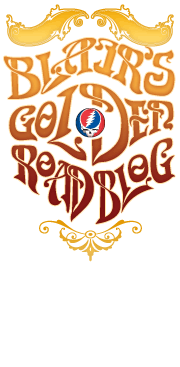The 35th anniversary of the release of the Dead’s Terrapin Station album on July 27, 1977, got me thinking about that magical year and how—or if—that disc fit into that time, and the ways it represented the Grateful Dead to the outside world.
First, a little background. By 1976, the Dead’s brave attempt to break away from the music business establishment by starting their own record labels (in mid-’73) and handling their own publicity, booking and travel arrangements, was weighing them down and causing undue amounts of stress. It turns out “hippie business empire” was an oxymoron. But the Dead were successful enough that there was plenty of interest in them from conventional labels, so when they went looking for a new situation, following a semi-disastrous interim distribution arrangement with United Artists, there were several potential suitors (in suits) waiting for them.
The most appealing was the boss of Arista Records, a successful new label formed by record biz legend Clive Davis. He had desperately wanted to sign the Dead back when he was president of Columbia Records, but couldn’t pry them away from Warner Bros.’ tight contract. He personally courted the band—especially Garcia, whom he admired tremendously (and had tried to sign as a solo act earlier)—and managed to convince the group and their managers that he was the guy who could take them to the next level. Clive believed that lurking underneath that loose, shambling, hippie exterior, lay a chart-topping band with unlimited commercial potential. Delusional? Perhaps. But you gotta love that kind of optimism.
Clive did have one major request. He wanted the band to work with an outside producer for the first time since the boys ran Dave Hassinger off the ranch back in the early stages of making Anthem of the Sun at the end of 1967. What, are you insane? The Grateful Dead? Amazingly, the band agreed, and after scoping out Clive’s list of potential candidates, settled on producer/engineer Keith Olsen, who was hot in the industry at the moment after making Fleetwood Mac’s eponymous breakthrough album. (He had previously worked with such disparate acts as Emerson, Lake & Palmer, Dr. John, and the James Gang.) Olsen and the band hit it off right away, and in the winter of ’77 the band headed down to L.A. to begin recording Terrapin Station at Sound City Studios in Van Nuys, Olsen’s recording headquarters.
A genuinely nice guy and easy-going on a personal level, Olsen could also be quite the taskmaster, and he wanted something from the Dead that no one had ever asked of them—perfection! He toiled with the group endlessly, trying to break them of what he saw as bad musical habits. He had Mickey and Bill orchestrate their parts in a way they never had before—having Mickey play hand percussion mostly, rather than traps—and he made sure every vocal harmony was completely on pitch, every guitar part in service of the pared-down radio-friendly songs. With the exception of the 16-minute suite dubbed “Terrapin Station, Part 1,” no song even reached 6 minutes; two were 3:30 (“Dancing in the Street” and “Samson & Delilah,” which in that era typically ran to about 15 minutes and 7 minutes respectively in concert), and one, “Passenger,” a mere 2:48. It was quite a change from their previous studio album, 1975’s Blues for Allah.
When the album was released, it seemed quite shocking, especially to those of us who had seen “Terrapin,” “Estimated Prophet” and “Passenger” develop and grow live over a few months (and in the case of “Dancing” and “Samson,” a full year) before the record came out. Not only had the songs been seriously truncated in a clear attempt to gain radio airplay, Olsen also had added innumerable production touches that fundamentally changed the sound of the band: sax and lyricon parts to “Estimated”; horns to the disco-fied “Dancing”; strings and horns to “Sunrise” (Donna’s moving ode to fallen road crew chief Rex Jackson); and a full orchestra and British chorale to the “Terrapin” suite. Most of those extra parts were added to the album by Olsen while the band was touring in the spring of ’77. But the group ultimately signed off on the album, deferring to their producer’s vision and whims.
I won’t lie—I was horrified at first. I wrote a review of Terrapin Station for the San Francisco Bay Guardian (8/18/77) in which I lauded the album as “the cleanest-sounding record the Dead have ever made” and complimented “the power and instrumental depth Olsen was able to get out of the Dead,” but slammed the “heavy-handed (or is that lead-fisted) production.” “Sunrise” was “buried in symphonic rubble,” the orchestra on “Terrapin Flyer” “churns out a nauseating melody that alternately sounds like the score of a James Bond movie and a soundtrack of a Bermuda travelogue,” and with the appearance of the choir, “Hunter and Garcia’s stunning piece has been slaughtered by an overzealous producer! For the first time ever, the Grateful Dead actually sound pretentious.” (Hey, BJ, mean people suck!)
The record sold fairly well, though not spectacularly, and certainly not up to Clive’s expectations. The hoped-for “hit single” remained a mirage. It didn’t seem to attract a new audience particularly, and it never gained much traction outside of the Dead world, even with the concession to disco, the glistening harmonies and short songs. It didn’t give a true picture of who the Grateful Dead were, and, as usual, it didn’t fit in with other prevailing pop music trends, from prog rock to new wave.
In interviews, some of the band members were critical of the album’s grandiose production—particularly Mickey, who was apoplectic about what Olsen did to “Terrapin Flyer.” Bob, however, was so enthusiastic about the recording experience that he immediately went back into the studio with Olsen to make Heaven Help the Fool. I’ve always believed that working under Olsen’s benign whip at least made the Dead a better band, and that the spectacular spring ’77 tour—the first after the studio sessions—is proof of that.
Once I got over my inflated expectations for what I felt the record should have been, I started to appreciate Terrapin Station on its own merits—as an example of what a producer with big ideas and commercial inclinations could do with an idiosyncratic outfit like the Grateful Dead.
Recently, after not having heard the album in several years, I gave the disc a serious, headphones-cranked listening, and I came away from the experience quite impressed. It helps that I know much more about both music and recording than I did in 1977, so now I can admire the obvious craft that went into making the album. The precision in the playing doesn’t sound so antiseptic to me; rather, it feels thoughtfully arranged, with great attention paid to mixing different guitar tones within each song (octave divider, envelope filter, half-speed tape manipulation, etc.), varying the percussion track to track, and using keyboards sparingly—mainly organ, rather than piano—just for color, rather than as a constant rhythmic element throughout. The backing vocals are carefully layered with multiple Donnas left, right and center, blending with Weir and Garcia (also doubled or more in places) to create a creamy whole. This was the era of producer Roy Thomas Baker’s audacious and highly influential vocal experiments with Queen (“Bohemian Rhapsody,” etc.) and, of course, Olsen had worked wonders with the stunning vocal trio of Lindsey Buckingham, Stevie Nicks and Christine McVie in Fleetwood Mac. There was no way he was going to wrangle that sound out Jerry, Bob and Donna, but he did succeed in giving their harmonies an appealing commercial glow. He also used different reverbs in creative ways on everything from drums to vocals. It’s a beautifully made record.
The orchestrations I rather cavalierly derided in my original review sound subtle and sophisticated to me today. (OK, “Sunrise” is still a bit bombastic.) The way the woodwinds and strings smoothly assert themselves at different points in “Terrapin” makes sense from an arrangement standpoint—if you’re willing to accept the notion that this is a studio construction not meant to mirror the way the Grateful Dead sounded live. I still don’t care for the chorale that comes in at the end of the “Terrapin” suite and warbles in the best Queen’s English until the final fade—it’s a bit precious, isn’t it? But on this latest listening I noticed something I’d forgotten: that the song actually concludes the last second before it fades out, with a final sung “Terrapin!”
I’ve always loved the studio version of “Estimated” (I never had a philosophical problem with Tom Scott’s sax taking the solo after the verses rather than Jerry), and “Passenger” remains one of the group’s all-time hottest rock tracks. “Samson” is a bit compact but still effective, and “Sunrise” beats most of the live versions—Donna was always a strong studio singer. I never warmed to this “Dancing in the Street.” The vocal arrangement lacks punch, and without the incredible instrumental jams that were part of the live versions, there’s really not much to it.
Terrapin Station remains a singular curiosity in the Dead’s catalog. It’s probably going too far to suggest it’s the Dead’s Sgt. Pepper (Aoxomoxoa fits that better), but it was definitely a bold stab at something unorthodox, a new way of presenting their music not tied to their performance persona. In the process, however, they lost some of their identity and diluted their essence. Still, its excesses were quickly forgiven and forgotten by the die-hard fans who never embraced it. For them, the real “Terrapin” was that one from last night’s show, or maybe the next to be played.
I always hoped that we’d eventually get to hear some of Olsen’s beautifully recorded versions of these songs stripped of the dross and gloss, but so far he has not assented to letting any of the work tapes leave his studio vault. What was “Terrapin Flyer” like before the flute and strings were added? More like “King Solomon’s Marbles”? Someday, perhaps, well find out.




